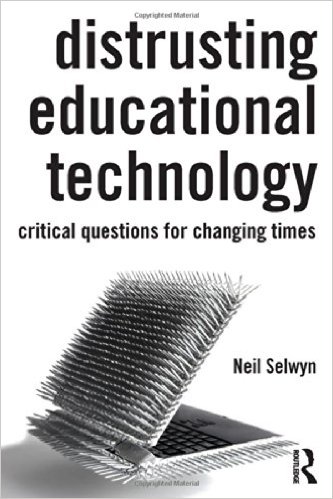Review – Distrusting Educational Technology (Part 1)
Two roads diverged in a yellow wood,And sorry I could not travel bothAnd be one traveler, long I stoodAnd looked down one as far as I couldTo where it bent in the undergrowth– Robert Frost, The Road Not Taken
I misread the cover of Neil Selwyn’s Distrusting Educational Technology (Routledge, 2013) when I first saw the book several years ago. It’s a brilliant cover: a laptop covered in nails.
Yet until I had completed the book cover to cover, I did not fully consider the scenario of a laptop computer covered in nails, unable to be accessed without some element of pain. For whatever reason, I have perused this book and read a chapter here and there over the past three years thinking the nails on the cover were less pain infliction and more art innovation, a harkening back to the kitsch sold at The Sharper Image in the late 20th Century.
It is tough to misread thousands of sharp objects (deployed for defensive engagement) as the cover photo for a book entitled Distrusting Educational Technology. Yet despite my commitment to critical edtech scholarship, I negotiated Selwyn’s stark imagery with my own hope, making lemons out of lemonade and making digit art out of nails. I came to the book with a mind to distrust, but behind my thoughtful skepticism was a belief in the transformational power of technology, an inherent trust in the field and in its potential.
This is an example of what Selwyn calls the system of radical optimism, a persistent belief despite the lack of immediate experience or evidence. Selwyn sees technology as not only ubiquitous in society, but as the failsafe used when determining how to alleviate the contemporary problems of the world. In the case of educational technology, we encounter truthiness — a continued bolstering of the field on the basis of wishful thinking rather than known facts. Technology will solve the problems, except it doesn’t solve the problems, but a quick bit of design thinking and we can get back on track and solve those problems. Repeat.
Critical scholars are quick to point out this behavior from entrepreneurs, policymakers and efficiency-based educators, but Selwyn notes the complicity of multiple factions of the EdTech field in perpetuating exhortative EdTech promises: instructors, administrators, even scholars. This is understandable, as people driven to the relatively new field of educational technology are often compelled through a sense of higher purpose for education as well as a belief in the potential for computer-based technologies. The result, however, is a hype factory perpetuating itself on multiple fronts: commerce and development selling the promise of technology on the front-end, instructors and administrators employing new waves of technology in the classroom, and scholars sharing the results of the new waves of technology in the classroom.
Even critical scholarship on EdTech largely focuses on technology systems and platforms. MOOCs are a prime example: Stanford does MOOCs, press is good, MOOCs promise democratic educational aspirations across the globe, scholarship focuses on the development and deployment of MOOCs, MOOCs grow, critical scholarship requests pause on MOOCs, MOOCs do not deliver the promises of democratic educational aspirations across the globe, MOOCs celebrate pivots/versioning while casually writing off the students originally promised transformation though education, most research remains focused on the development and deployment of MOOCs while critical scholarship moves to the next system. Today, five years after Sebastian Thrun’s CS 271 registered 160,000 students and 160,000 think pieces, the media frenzy around MOOCs has abated but MOOCs continue to raise money and be tied to disruptive innovation and remain promises of the potential of higher education in the 21st Century. The promises of MOOCs in 2012 and 2013, the goals and aspirations and utopia ensuing from massive open online courses is gone. Some see this as a tsunami false alarm. Many continue to work on MOOCs in their day to day operations. Others consider the MOOC a phenomenon to be studied as a relic of a space and time. But very few in the world of EdTech have considered the inverse…that the problem of educational technology is not that x technology failed to deliver on y promise, but rather that based on almost 40 years of history there is no empirical reason to believe any technology will deliver on any of our educational promises.
This is a difficult space for an educator. Our field is made up of people with a desire to see improvement in the lives of others. Inherent in the student/mentor relationship is a promise, a promise that dedication from both parties will result in an improvement, potentially a transformation, and that education is a foundation for life improvement beyond the scope of a lesson or a course. I read over this paragraph and see the trust I have in education. And this is where Selwyn notes the power of hegemony, of dominant interests and overarching cultural influences moving the discussion on education to serve the interests of society. The individual actors (students, educators, administrators, developers, entrepreneurs, scholars) are often driven by a desire to provide the scaffolding for improvement, but their intentions do as much to serve the dominant ideological interests of society as they do a student body.
The rise of classroom computing mirrors the rise of societal celebration of personal spirit, what Duncan-Andrade called a mythical hope rooted in celebrating individual exceptions. The subsequent discussion of libertarian mindsets and neoliberal policies provides a reasoned and scholarly-backed history for these terms often relegated to the pejorative; Selwyn roots the political changes in the Western world with the growth of computer culture, making a compelling argument that the mid-20th Century military-driven computing culture transitions to a hippie culture of open source computing in the late-20th Century (with an interesting argument regarding the less than altruistic aims of many open source developers), and the logical conclusion of both our technological and our political directions in the early 21st Century is the by-choice community, protected by a wall or an ocean. The discussion of the political is necessary, as Selwyn notes on the book’s first page the relationship between politics and education, and throughout the book pinpoints the spaces where various EdTech stakeholders attempt to neutralize or depoliticize the field and its work.
There are four current trends in educational technology where Selwyn analyzes and deconstructs the myths with the realities; they are important, and I would suggest Wendy Grossman’s review of the book at DML Hub for specifics.
Selwyn’s set-up (all of EdTech is complicit in its perpetuation of false promises) and evidence come to fruition in the final two chapters where he notes the contradictions of our beliefs versus our actions and the unintended by powerful effects. Those chapters deserve a post of their own and not to be lost in the back third of a too-long review.
But how to end here, before the end? Or yet, how to end even when we get to the end, where there are no magic solutions or steps to recovery. Selwyn discusses in the preface of his book the difficulty in writing a book without an uplifting end. His response is to focus on the intended purpose of education as a driving agent for his and our work, and quotes the Italian theorist Antonio Gramsci: “I am a pessimist because of intelligence, but an optimist because of will.”




Leave a comment